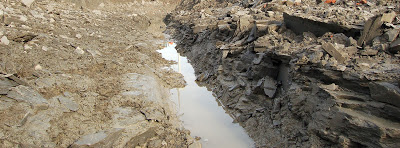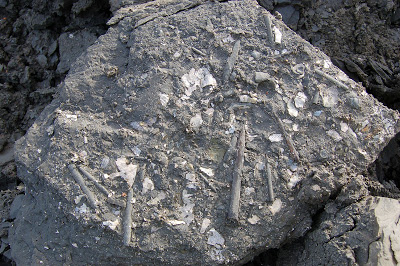

| Visitors Now: | |
| Total Visits: | |
| Total Stories: |

| Story Views | |
| Now: | |
| Last Hour: | |
| Last 24 Hours: | |
| Total: | |
Still Searching
Saturday, February 23, 2013 11:23
% of readers think this story is Fact. Add your two cents.
A recent field trip saw the group arrive at a secret location early in the morning ready to start the hunt for marine reptiles once again. As we chatted before moving off we were aware that the venue had now become vulnerable to poaching and vandalism and it was with a little trepidation that we started to prospect. As usual, and a shame that we have to do so, we had kept our field activities quiet and left nothing to chance – we had to. Deny everything.
The morning was cool and clear and the sun was breaking through a treat – this would be the first decent day in months. A great swathe of ancient marine sediments lay ahead of us and, no matter how many times you may have looked in these formations, you know that there is, somewhere out there, another great Mesozoic saurian ready to start weathering out of the ancient mud rocks.
Immediately there are fossils to behold. Throughout the rocks there are literally thousands of specimens representing a multitude of species. Some of them are quite stunning, especially the better preserved ammonites and it defies belief that these delicate impressions in the rocks have survived for over 160 million years. It never fails to amaze when trying to comprehend such vast time spans and to imagine what has come and gone during our prehistoric past. Indeed it is always a great leveller to remember how long Homo sapiens has actually existed in comparison to the total duration of life on earth – in so many ways we are pathetically insignificant.
We approach a long gully, pause and then take a quick descent into the base of it – this looks like it could be quite a productive site – if not now then certainly after there has been some more weathering by the elements. That this could be the case was confirmed by the presence of large well preserved belemnites – something that we have not seen in many months of prospecting. We believe, more in hope than anything else, that this site will yield something significant to us rather than be illegally plundered by the poachers.
As we prospected along the gully we realised that it was probably just above the more productive level we would have preferred and some of the zonal fossils in situ confirmed this – especially one particular cephalopod which is proving particularly interesting. None the more for that, the sediments were highly fossiliferous and we managed a couple of metriorhynchid teeth and what appears to be a metriorhychid cervical rib – a well preserved piece of bone.
 |
| Part of the gully |
We spent a lot of time in and around the gully before spreading out and widening the search. The weak winter sun was actually making conditions a lot warmer and, with no wind, I was able to shed some clothing and as a result felt a lot more agile whilst looking. Despite this, wet conditions prevailed and we all had to be wary of where we were putting our feet. I think every single one of us managed to get at least one foot stuck in the mire at some point in the day.
It occurred to me during the day how lucky we were considering. Gone are the days when there would have been many productive sites, both coastal and inland, whereby you could approach a landowner and be allowed to search for fossils on their land with no repercussions whatsoever. Similarly, it was commonplace to be allowed to visit working quarries and prospect – again by simply approaching the owners and applying for access. Today, the vast majority of working quarries are closed and with those that are still operating, access is usually denied.
I guess myself and other members of the group are perhaps the last of the lucky ones. We are perhaps not as fortunate as our colleagues in places such as North America which has vast tracts of wilderness to explore but it is hard to see how many students and amateur UK palaeontologists will get the chance of field opportunities in their own back yard in the future. I know that this causes great consternation with some senior geologists and palaeontologists who have seen the field work section in courses now dropped in favour of “cyber-fieldwork”. We hope, in time, to be able to help address this particular problem in some small way.
Of course, on the other side of the coin, is that some researchers actually prefer to be in the laboratory and seldom venture out into the wild. That is fair enough but you cannot help but feel that they are missing out, not in a research or technical sense, but perhaps in connecting with the very world that they are investigating. This may not appear to be a rational thought but it is often true.
The members of the group all have field experience and most have been involved in excavating dinosaurs and/or marine reptiles in some capacity. This in itself brings a unique camaraderie that only those who have experienced field work will understand. Tales of triumph and woe are legion but they are all equally remembered – it is a fact that field experience does indeed enrich the palaeontologist’s life. Lunch time is the classic period for field chat and it is always great to hear of events past and present and it never fails to amaze me that, no matter how long you spend with your friends and colleagues, so many new stories come out on each and every field visit.
We continued our prospecting, checking out new areas as well as those that had produced in the past. Some of the old areas were completely barren or had eroded so much that they were almost unrecognisable whilst others were under water or buried in a conglomerate of sediment. The more time we spend in these formations the more we realise that getting exactly the right conditions that help you find vertebrate fossils are very few and far between. Indeed, I can think of only two trips during the whole of last year that could be considered ideal.
Eventually we decide to return to the gully and take images and make some notes. We notice that there are some very strange preservational issues that need checking out and are fortunate that some of the larger exposed slabs enable us to make some interesting comparisons. We pay particular attention to the ammonites because they will enable us to precisely identify the exposed bed and a few of the unusually preserved fossils we had found earlier make the task intriguing.
Eventually we had to call it a day and, as usual, we are always sorry that we have to go although our limbs and backs tend to disagree with that statement. Our calves in particular feel the pressure when you are often plunging your feet into a thick mix of mud, clay and water all day – it really does tell on you. With the lengthening of the days and an increase in the temperature we all look forward to more productive days in the field and I find myself yearning for some spring sunshine. Who knows? Perhaps we will have a summer this year.
2013-02-23 11:03:48
Source: http://saurian.blogspot.com/2013/02/still-searching.html
Source:



